AI video generation is moving incredibly fast. If last year was defined by the surprise of models like OpenAI's original Sora, this year is all about the competition between two new heavy-hitters: OpenAI Sora 2 and Google's Veo 3.1. With both platforms promising to turn simple text into cinematic-quality video, creators are left with a critical question: which one is better?
This blog post provides a detailed, fact-based comparison to help creators, marketers, filmmakers, and developers understand the key differences. Our goal is to give you the clarity needed to decide which tool best fits your project's needs. We'll dive deep into each model's core features, put them head-to-head in a direct comparison table, explore specific use-case scenarios, and even provide a set of custom prompts designed to test the limits of each platform.
Sora 2 vs. Veo 3.1: Head-to-Head Feature Comparison
While both models aim to create stunning videos from text, they approach the task with different core strengths. Sora 2 excels at capturing moments with breathtaking realism, boasting a superior physics engine perfect for dynamic, short-form content. In contrast, Veo 3.1 is engineered for narrative, offering longer video generation and powerful tools to ensure characters and styles remain consistent throughout a story.
Let's break down how these differences play out feature by feature.
Video Length
- Veo 3.1: Wins with up to 2 minutes, ideal for short films, detailed explainers, and story-driven ads.
- Sora 2: Limited to 60 seconds, better suited for social media clips, ads, and scene prototyping.
Realism and Consistency
- Veo 3.1: Excels in temporal consistency over longer durations, ensuring characters and objects remain consistent across scenes.
- Sora 2: Praised for its superior physics simulation, making interactions like water splashes and fabric movement feel incredibly authentic in shorter clips.
Narrative and Editing Control
- Veo 3.1: Offers granular control with Scene Extension (adding to a clip), First/Last Frame Control (bridging two images), and Clip Transformation (changing styles).
- Sora 2: Features Multi-shot editing, allowing the AI to generate and stitch together different scenes into a single, fluid narrative.
Image-Based Generation
- Veo 3.1: Allows up to 3 reference images to guide character, object, or style consistency, a powerful feature for branded content or character-driven stories.
- Sora 2: Offers a general image-to-video mode for animating static photos. However, it comes with very strict content policies, especially regarding the use of images depicting real people, to prevent misuse.
Audio Capabilities
Both models feature synchronized audio generation, including sound effects, ambient noise, and dialogue. This is a point of parity, showing the industry standard is moving towards complete audio-visual experiences.
Safety and Ethics
- Veo 3.1: Uses SynthID, an invisible watermark to identify AI-generated content.
- Sora 2: Includes built-in ethical AI safeguards to prevent harmful content generation.
Pricing & Accessibility: Available Now on MimicPC
Accessing these state-of-the-art models is now a reality. Here at MimicPC, we've integrated both Sora 2 and Veo 3.1, offering a clear, pay-per-generation pricing structure that reflects the unique capabilities of each model.
The pricing on our platform is as follows:
- Veo 3.1: $0.50 for an 8-second video (approximately $0.06 per second).
- Sora 2: $0.50 for a 4-second video (approximately $0.12 per second).
Sora 2 vs. Veo 3.1: A Detailed Comparison Table
Feature | Sora 2 | Veo 3.1 |
Video Length | Up to 60 seconds | Up to 2 minutes |
Core Strength | Superior physics simulation, creating extreme realism and dynamic motion. | Excellent temporal consistency, ensuring stable characters and scenes in longer videos. |
Editing & Control | Multi-shot editing: AI automatically generates and sequences different shots (wide, close-up, etc.) to build a narrative. | Granular tools: Supports scene extension, first/last frame control, and style transformation for director-level control. |
Image-based Generation | Can animate static images, but has strict content restrictions on real human faces. | Supports up to 3 reference images to lock in style, character appearance, or product design. |
Resolution | Standard 1080p, with potential for native 4K generation or upscaling. | Standard 1080p, with a target of providing 4K high-definition output. |
Audio Capabilities | Supports synchronized generation of sound effects, ambient noise, and AI dialogue. | Supports synchronized generation of sound effects, ambient noise, and AI dialogue. |
Safety & Ethics | Proactive Content Classifiers: Rejects inappropriate prompts before generation begins. | SynthID Watermarking: Embeds an invisible, permanent digital watermark for traceability. |
Pricing on MimicPC | $0.50 / 4 seconds (Approx. $0.12 per second) | $0.50 / 8 seconds (Approx. $0.06 per second) |
Sora 2 vs. Veo 3.1: A Head-to-Head Prompt Test
A feature list only tells part of the story. To truly understand the practical strengths and weaknesses of Sora 2 and Veo 3.1, we must put them to the test with prompts designed to push their specific capabilities to the limit. We've crafted a gauntlet of creative challenges, each targeting a key aspect of AI video generation. Here’s the breakdown of our testing methodology.
Test 1: Realism from a Simple Prompt
Objective: To evaluate the model's ability to deconstruct a concise, simple prompt into a complex, chaotic scene with multiple interacting agents (both animal and human). This tests the AI's world knowledge and its capacity to simulate believable, simultaneous interactions.
The Prompt:
"Seagulls raid the pier and steal fries from tourists, vertical 9:16.
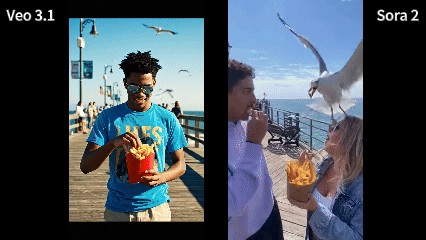
Test Results:
- Sora 2: Delivered a highly realistic result that felt authentic and raw. The video looked like it was genuinely shot on a smartphone, making it perfect for platforms like TikTok. The movements of the tourists and seagulls, the chaotic atmosphere, and the ambient sound design were all incredibly believable.
- Veo 3.1: Produced a video with a more polished, cinematic quality. While Sora 2 aimed for realism, Veo 3.1 added a layer of visual gloss. Interestingly, even without specific dialogue in the prompt, the background chatter and sounds generated by Veo 3.1 were slightly clearer and more distinct.
Test 2: Human Realism and Subtle Nuance
Objective: To assess the model's ability to generate a realistic human face, a notoriously difficult task that often falls into the "uncanny valley." This test also probes its understanding of subtle lighting, specific social media aesthetics, and camera simulation.
The Prompt:
"Beauty influencer selfie vlog, soft window light, subtle glam makeup, casual chat “get ready with me”; vertical 9:16, handheld phone camera."
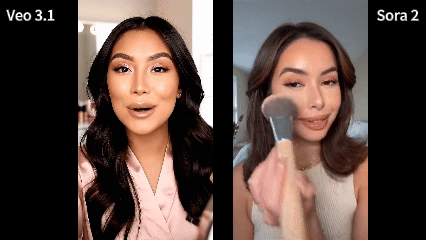
Test Results:
- Both models performed exceptionally well on this test. They successfully generated highly realistic human characters, completely avoiding the uncanny valley. The unscripted dialogue they generated felt natural and appropriate for the "get ready with me" context, and the subtle actions of applying makeup and chatting to the camera were rendered with convincing realism.
Test 3: Character & Object Consistency from Reference
Objective: This is a stress test for one of Veo 3.1's flagship features: consistency. By providing a reference image, we are demanding that the model not only generate a video but also maintain the precise identity of a character and an object across a high-energy scene.
The Prompt:
"Use the exact same dog from my uploaded photo and keep the dog’s appearance and expression consistent across all shots (no changes to coat, markings, size, or accessories). Set the scene in an office: the dog “works” at a desk with a nameplate, notebook, sticky notes, and a water cup, seated on a low chair or cushion facing a computer. Include locked-off front angles, side medium angles, and close-ups of keyboard and dog paws; the dog occasionally taps the keyboard, nudges the mouse with its nose, carries a sticky note to a coworker, or tilts its head at a ringing phone. Daytime office lighting with a soft desk lamp; ambient typing, printer whirr, and quiet chatter. Maintain strict continuity of the same dog and a consistent set of office props."
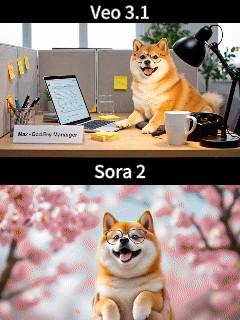
Test Results:
- Both models succeeded in the core task of maintaining the consistency of the dog's appearance, including details like the pair of glasses it was wearing. However, there was a clear difference in execution.
- Sora 2: Created a much more dynamic and lively video. It incorporated multiple camera angles and shot changes, making the scene feel more like a finished edit. The dog's actions were more energetic and vivid, and the background audio of a busy office added a layer of immersion.
- Veo 3.1: While it perfectly maintained consistency, the resulting video was comparatively stiff and rigid. It felt more like a single, static shot, lacking the dynamic energy and narrative flair that Sora 2 was able to produce.
Test 4: Cinematic Control and Multi-Shot Editing
Objective: To evaluate the AI's ability to function as a film editor by interpreting a timed shot list. This tests its capacity to generate distinct, well-composed camera angles and sequence them together seamlessly, a key promise of Sora 2's "multi-shot" feature.
The Prompt:
"An 8-second cinematic sequence detailing the art of making espresso.
[0-2s] Wide establishing shot of a modern, minimalist café. A barista stands behind a gleaming espresso machine.
[2-4s] Hard cut to a top-down macro shot of dark coffee beans being ground, particles flying in slow motion.
[4-6s] Cut to an extreme close-up of rich, dark espresso pouring into a white ceramic cup.
[6-8s] Final hero shot, slow push-in on the finished latte with perfect rosetta art, steam gently rising."
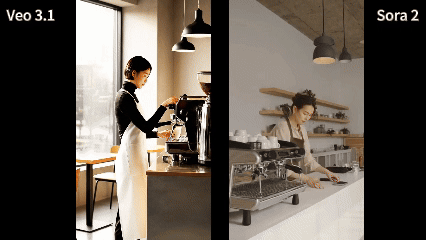
Test Results:
- Both models successfully followed the multi-shot script, generating all the requested angles in the correct sequence.
- Sora 2: Excelled in realism. The barista in the opening shot moved naturally, the physics of the coffee beans being ground were believable, and the final espresso shot looked delicious and authentic. The shorter video duration resulted in tight, crisp pacing that was very effective and pleasing to watch.
- Veo 3.1: Struggled with realism in this test. The barista in the first shot was nearly static, breaking the illusion of a live scene. Furthermore, the shot of the coffee beans being ground did not look physically accurate. While it followed the script, the underlying visuals were not as convincing.
Test 5: Advanced Audio-Visual Synchronization with Dialogue
Objective: This is the ultimate test of audio-visual cohesion. The prompt provides a complete script with timed actions, layered sound design, and spoken dialogue.
The Prompt:
"Two men are filming in a podcast studio.
First man says, "We're finally here, anyone can make a podcast now."
The second man responds, "I just don't know what to talk about."“
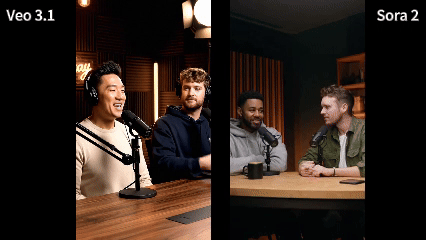
Test Results:
- Veo 3.1: This was a clear win for Veo. It generated a longer video, which allowed for more natural conversational pauses and pacing, making the dialogue feel more authentic. The video was rendered in higher definition, with crisp, realistic details on the characters. The lip-sync and audio quality were flawless.
- Sora 2: While it followed the prompt, Sora 2 showed some minor weaknesses here. There were some strange artifacts and a lack of detail in the characters' hands. Additionally, the facial expressions were subtly odd, which slightly undermined the realism of the performance.
Conclusion
After running both models through this gauntlet, a clear pattern emerges. This isn't a simple case of one model being "better" than the other; rather, they exhibit different creative philosophies.
Veo 3.1 is the Cinematic Director. It excels at producing high-fidelity, polished video with a rich, cinematic color palette. Its greatest strength lies in generating clear, natural-sounding dialogue and maintaining pristine character detail, as seen in the podcast test. However, it can sometimes be too rigid, prioritizing polish over dynamic action or physical realism.
Sora 2 is the Authentic Documentarian. Its strength is in raw realism. It consistently produces video that feels like it was captured in the real world, excelling at complex physics, chaotic scenes, and dynamic editing. It creates content that feels native to social media and documentary-style filmmaking. Its weakness appears in the fine details of human performance, where it can sometimes produce minor but noticeable artifacts.
In summary: If your goal is a polished, dialogue-driven scene with a film-like quality, Veo 3.1 is the stronger choice. If you need to capture authentic, dynamic, and physically believable action, Sora 2 currently has the edge.
Final Conclusion: No Absolute Winner, Only the Best Choice for You
After putting both models through this series of rigorous, head-to-head tests, it’s clear that the showdown between Sora 2 and Veo 3.1 isn't a simple contest of "who is better." Instead, it's a showcase of two distinct creative philosophies.
Veo 3.1 is a seasoned film director. It excels at producing high-fidelity, polished video with a rich, cinematic color palette. As its official page highlights, it shines when generating clear, natural-sounding dialogue and maintaining character consistency through multi-image references. If your goal is a dialogue-driven, polished short film with a strong narrative feel, Veo 3.1 is undoubtedly your top choice.
Sora 2 is an authentic documentarian. Its core strength lies in its unparalleled realism and physics simulation. Whether handling chaotic, dynamic scenes or seamlessly stitching together multiple shots, Sora 2 generates video that feels like it was captured in the real world, making it perfect for creators aiming for a raw, documentary feel or viral-ready content.
So, the ultimate choice lies with you and your creative needs. The best way to find out is to experience them firsthand and see which tool resonates with your imagination. Fortunately, on MimicPC, you don’t have to choose. Both leading models are ready and waiting for you to explore.
Start your AI video creation journey now and find the perfect fit for you!
- Try Veo 3.1 now: Give your story a cinematic feel and crystal-clear dialogue with Veo 3.1.
- Try Sora 2 now: Capture breathtaking moments of dynamic action and realistic physics with Sora 2.
